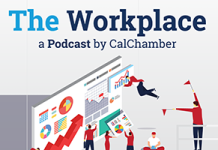In this episode of The Workplace podcast, CalChamber Executive Vice President and General Counsel Erika Frank and employment law expert Jennifer Shaw discuss the obligations employers have if they decide to monitor off-duty employees as a means of reducing the spread of COVID-19 in the workplace.
The question of whether employers should monitor the activities of their workers when they are off the clock is a very popular question at the CalChamber Labor Law Helpline at the moment, Frank tells listeners. Employers are under a lot of pressure to reduce the risk of COVID-19 spread and provide a safe workplace for their employees. Understandably, many employers are worried that workers may bring the virus into the office.
Shaw cautions that any employer who wants to monitor what employees are doing outside of work needs to be clear and transparent about what the employer is doing, especially given that there is no consistent local, state or federal guidance on the subject.
Must Have a Reasonable Belief
Frank points out that even before shelter-in-place orders were issued, employers were asking whether they could force workers to self-quarantine if they had traveled by air.
Currently, employers should have a reasonable belief that the employee poses a risk to the workplace if they want to require the worker to self-quarantine or take medical tests, Shaw explains.
“That’s the whole reason why we can do things with COVID-19 that we can’t do with a regular medical condition,” she tells Frank. “All of the rules have sort of been turned on their head in terms of what employers can do in this area.”
Obligations
If an employer asks that a worker take a medical test, the employer will have to pay the costs of the test itself, and for the time it takes the employee to take the test, Shaw explains. But even something as simple as monitoring one’s temperature at home can incur reporting time pay obligations, at a minimum of two hours and a maximum of four hours, Shaw says.
“You are imposing a burden and obligation on the employee. So for a non-exempt employee, [employers] will have to pay for that time,” she says.
And the obligations can go on and on, Shaw adds.
Many employers want a one-size-fits-all template answer, but unfortunately each case must be assessed differently, she tells Frank.
Resources
Many online resources address COVID-19, but the best places to turn to are the U.S. Centers for Disease Control and Prevention website and the California COVID-19 government website, Shaw says.
The California COVID-19 website also features a resilience roadmap that breaks down recommendations by industry and outlines the steps businesses need to take to reopen or bring employees back to work.
Frank also recommends that employers regularly check the CDC website, as COVID-19-related information is constantly changing as health officials learn more about the virus. The website can be counted on to be updated with the most current information available.


